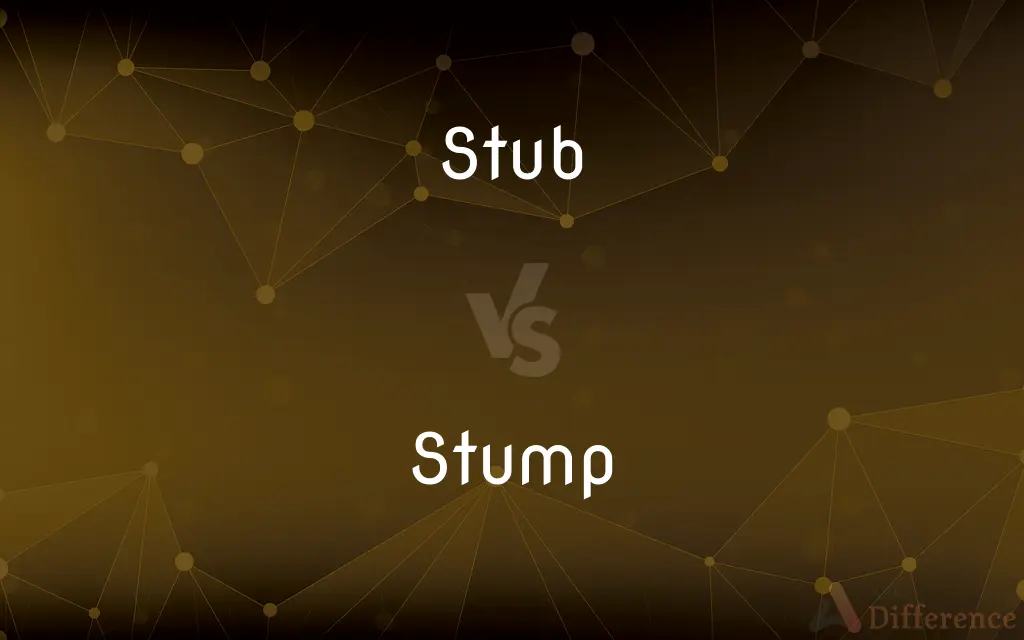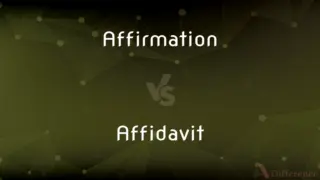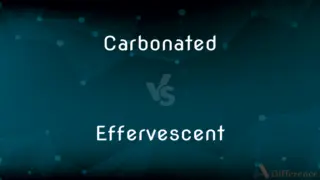Stub vs. Stump — What's the Difference?
By Tayyaba Rehman & Urooj Arif — Updated on April 4, 2024
A stub is the small remaining part of something that has been cut or worn away, while a stump is the bottom part of a tree left protruding from the ground after most of the trunk has been cut down.

Difference Between Stub and Stump
Table of Contents
ADVERTISEMENT
Key Differences
A stub typically refers to a small remaining portion of an object that has been used or worn down. This term is often associated with items like tickets, where the detachable part is kept as proof of payment, or cigarettes, where the unsmoked remainder is discarded. On the other hand, a stump specifically refers to the remainder of a tree trunk left in the ground after the tree has been felled. It is generally larger and rooted in place, unlike the more mobile or disposable nature of a stub.
While stubs can be found in various contexts, such as the remnants of a pencil after extensive sharpening or the end piece of a loaf of bread, stumps are exclusively associated with trees and arboreal contexts. The term "stump" evokes images of forestry, tree removal, and natural landscapes, whereas "stub" has a broader application, touching on everyday objects and scenarios.
The processes leading to the creation of stubs and stumps also differ. Stubs result from the consumption or use of an item down to its base part, often through actions like writing, smoking, or tearing. Conversely, stumps are created through the deliberate act of cutting down trees, a process usually undertaken for reasons like lumber production, land clearing, or safety concerns.
In terms of their treatment and management, stubs and stumps offer different challenges. Stubs are usually disposed of or occasionally saved, as in the case of ticket stubs for sentimental or record-keeping reasons. Stumps, however, may require additional efforts to remove or repurpose, given their size and rooted nature. They can be left in place for ecological reasons, removed through stump grinding, or incorporated into landscaping designs.
While both stubs and stumps can be seen as remnants of something larger, their scale and permanence vary. Stubs are small, easily overlooked, and often transient, destined for disposal or recycling. Stumps, however, can have a lasting presence in an environment, sometimes becoming habitats for wildlife or sprouting new growth, serving as a reminder of the tree that once was.
ADVERTISEMENT
Comparison Chart
Definition
The small remaining part of something used or worn away.
The bottom part of a tree trunk left in the ground after the tree is cut down.
Context
Various (tickets, cigarettes, pencils).
Specifically related to trees and forestry.
Creation Process
Resulting from use or consumption.
Resulting from the deliberate act of cutting down a tree.
Size and Scale
Small and easily disposed of.
Larger, rooted, and may require effort to remove.
Post-Creation
Often discarded, sometimes kept for records or sentimental value.
May be left as is, removed, or repurposed in landscaping.
Compare with Definitions
Stub
The remnant of a used pencil.
Only a stub of the pencil remained after the exam.
Stump
The bottom part of a tree trunk left in the ground.
The old oak's stump was all that remained.
Stub
A small remaining piece of something.
She kept the movie ticket stub as a souvenir.
Stump
A remnant of a tree after it has been cut down.
The stump was covered in moss and mushrooms.
Stub
The end piece of a loaf of bread.
No one wanted to eat the bread stub.
Stump
A portion of the trunk showing the tree's age rings.
Children counted the rings on the stump to guess the tree's age.
Stub
The leftover part of a cigarette.
The ashtray was full of cigarette stubs.
Stump
A rooted tree base that may sprout new growth.
New shoots sprang from the stump in spring.
Stub
A partial ticket retained as proof of payment.
He showed the bus stub to the inspector.
Stump
A natural structure used in creative landscaping.
They carved the stump into a rustic garden chair.
Stub
The usually short end remaining after something bigger has been used up
A pencil stub.
A cigarette stub.
Stump
The part of a tree trunk left protruding from the ground after the tree has fallen or has been felled.
Stub
Something cut short or arrested in development
A stub of a tail.
Stump
A part, as of a branch, limb, or tooth, remaining after the main part has been cut away, broken off, or worn down.
Stub
The part of a check or receipt retained as a record.
Stump
Stumps(Informal) The legs.
Stub
The part of a ticket returned as a voucher of payment.
Stump
An artificial leg.
Stub
An entry that has minimal text, no text, or has not been written in full in an online reference work.
Stump
(Derogatory) A short, thickset person.
Stub
To pull up (weeds) by the roots.
Stump
A heavy footfall.
Stub
To clear (a field) of weeds.
Stump
A place or an occasion used for political or campaign oratory
Candidates out on the stump.
Stub
To strike (one's toe or foot) against something accidentally.
Stump
A short, pointed roll of leather or paper or wad of rubber for rubbing on a charcoal or pencil drawing to shade or soften it.
Stub
To snuff out (a cigarette butt) by crushing.
Stump
(Sports) Any of the three upright sticks in a cricket wicket.
Stub
Something blunted, stunted, or cut short, such as stubble or a stump.
Stump
To reduce to a stump.
Stub
A piece of certain paper items, designed to be torn off and kept for record or identification purposes.
Check stub
Ticket stub
Payment stub
Stump
To clear stumps from
Stump a field.
Stub
(programming) A placeholder procedure that has the signature of the planned procedure but does not yet implement the intended behavior.
Stump
To stub (a toe or foot).
Stub
A procedure that translates requests from external systems into a format suitable for processing and then submits those requests for processing.
Stump
To walk over heavily or clumsily.
Stub
A row heading in a table (with horizontal reference, whereas a column heading has vertical reference).
Stump
To traverse (a district or region) making political speeches.
Stub
A Wikipedia article providing only minimal information and intended for later development.
Stump
To shade (a drawing) with a stump.
Stub
The remaining part of the docked tail of a dog
Stump
To challenge (someone); dare.
Stub
An unequal first or last interest calculation period, as a part of a financial swap contract
Stump
To cause to be at a loss; baffle
Stumped the teacher with a question.
Stub
(obsolete) A log or block of wood.
Stump
To walk heavily or clumsily.
Stub
(obsolete) A blockhead.
Stump
To go about making political speeches.
Stub
A pen with a short, blunt nib.
Stump
The remains of something that has been cut off; especially the remains of a tree, the remains of a limb.
Stub
An old and worn horseshoe nail.
Stump
(politics) The place or occasion at which a campaign takes place; the husting.
Stub
Stub iron.
Stump
(figurative) A place or occasion at which a person harangues or otherwise addresses a group in a manner suggesting political oration.
Stub
The smallest remainder of a smoked cigarette; a butt.
Stump
(cricket) One of three small wooden posts which together with the bails make the wicket and that the fielding team attempt to hit with the ball.
Stub
(transitive) To remove most of a tree, bush, or other rooted plant by cutting it close to the ground.
Stump
(drawing) An artists’ drawing tool made of rolled paper used to smudge or blend marks made with charcoal, Conté crayon, pencil or other drawing media.
Stub
(transitive) To remove a plant by pulling it out by the roots.
Stump
A wooden or concrete pole used to support a house.
Stub
(transitive) To jam, hit, or bump, especially a toe.
I stubbed my toe trying to find the light switch in the dark.
Stump
A leg.
To stir one's stumps
Stub
The stump of a tree; that part of a tree or plant which remains fixed in the earth when the stem is cut down; - applied especially to the stump of a small tree, or shrub.
Stubs sharp and hideous to behold.
And prickly stubs instead of trees are found.
Stump
A pin in a tumbler lock which forms an obstruction to throwing the bolt except when the gates of the tumblers are properly arranged, as by the key.
Stub
A log; a block; a blockhead.
Stump
A pin or projection in a lock to form a guide for a movable piece.
Stub
The short blunt part of anything after larger part has been broken off or used up; hence, anything short and thick; as, the stub of a pencil, candle, or cigar.
Stump
To stop, confuse, or puzzle.
Stub
A part of a leaf in a check book, after a check is torn out, on which the number, amount, and destination of the check are usually recorded.
Stump
To baffle; to make unable to find an answer to a question or problem.
This last question has me stumped.
Stub
A pen with a short, blunt nib.
Stump
(intransitive) To campaign.
He’s been stumping for that reform for months.
Stub
A stub nail; an old horseshoe nail; also, stub iron.
Stump
To travel over (a state, a district, etc.) giving speeches for electioneering purposes.
Stub
To grub up by the roots; to extirpate; as, to stub up edible roots.
What stubbing, plowing, digging, and harrowing is to a piece of land.
Stump
To get a batsman out stumped.
Stub
To remove stubs from; as, to stub land.
Stump
To bowl down the stumps of (a wicket).
Stub
To strike as the toes, against a stub, stone, or other fixed object.
Stump
(intransitive) To walk heavily or clumsily, plod, trudge.
Stub
A short piece remaining on a trunk or stem where a branch is lost
Stump
(transitive) To reduce to a stump; to truncate or cut off a part of.
Stub
A small piece;
A nub of coal
A stub of a pencil
Stump
(transitive) To strike unexpectedly; to stub, as the toe against something fixed.
Stub
A torn part of a ticket returned to the holder as a receipt
Stump
The part of a tree or plant remaining in the earth after the stem or trunk is cut off; the stub.
Stub
The part of a check that is retained as a record
Stump
The part of a limb or other body remaining after a part is amputated or destroyed; a fixed or rooted remnant; a stub; as, the stump of a leg, a finger, a tooth, or a broom.
Stub
The small unused part of something (especially the end of a cigarette that is left after smoking)
Stump
The legs; as, to stir one's stumps.
Stub
Strike against an object;
She stubbed her one's toe in the dark and now it's broken
Stump
One of the three pointed rods stuck in the ground to form a wicket and support the bails.
Stump
A short, thick roll of leather or paper, cut to a point, or any similar implement, used to rub down the lines of a crayon or pencil drawing, in shading it, or for shading drawings by producing tints and gradations from crayon, etc., in powder.
Stump
A pin in a tumbler lock which forms an obstruction to throwing the bolt, except when the gates of the tumblers are properly arranged, as by the key; a fence; also, a pin or projection in a lock to form a guide for a movable piece.
Stump
To cut off a part of; to reduce to a stump; to lop.
Around the stumped top soft moss did grow.
Stump
To strike, as the toes, against a stone or something fixed; to stub.
Stump
To challenge; also, to nonplus.
Stump
To put (a batsman) out of play by knocking off the bail, or knocking down the stumps of the wicket he is defending while he is off his allotted ground; - sometimes with out.
A herd of boys with clamor bowled,And stumped the wicket.
Stump
To walk clumsily, as if on stumps.
Stump
The base part of a tree that remains standing after the tree has been felled
Stump
The part of a limb or tooth that remains after the rest is removed
Stump
(cricket) any of three upright wooden posts that form the wicket
Stump
A platform raised above the surrounding level to give prominence to the person on it
Stump
Cause to be perplexed or confounded;
This problem stumped her
Stump
Walk heavily;
The men stomped through the snow in their heavy boots
Stump
Travel through a district and make political speeches;
The candidate stumped the Northeast
Stump
Remove tree stumps from;
Stump a field
Common Curiosities
Can stubs be reused or repurposed?
Stubs are typically disposed of, though they can be kept for sentimental reasons or as records, unlike stumps, which may be repurposed or require removal.
What is a stub?
A stub is the small leftover portion of something that has been significantly used or worn down.
What is a stump?
A stump is the bottom part of a tree trunk that remains in the ground after the tree has been cut down.
Are there environmental benefits to leaving stumps?
Yes, stumps can provide habitats for wildlife, support new tree growth, and contribute to the ecosystem's health.
How do stubs and stumps differ in context?
Stubs can refer to various small remnants, while stumps specifically relate to the remains of tree trunks.
Can stubs have any value?
Ticket stubs or similar items can have sentimental value or serve as collectibles, providing a tangible link to past events.
Why are stumps left in the ground?
Stumps may be left for ecological reasons, to prevent erosion, for aesthetic purposes, or due to the difficulty of removal.
How can a stump be removed?
Stump removal can be achieved through mechanical grinding, chemical treatments, or natural decomposition methods.
How are stubs and stumps similar?
Both are remnants of something larger and serve as physical reminders of what was once there.
Can stubs of plants lead to new growth?
Similar to tree stumps, the stubs of certain plants can regenerate or sprout new growth under the right conditions.
What makes a stump different from a log?
A stump is rooted in the ground and remains after a tree is cut down, while a log is a cut section of the tree trunk that can be moved.
Do stumps need to be treated or maintained?
Stumps can be left as is, but may require treatment or maintenance if they pose safety hazards or if removal is desired.
Is it possible for a stump to grow back into a tree?
Some stumps can sprout new shoots, potentially growing back into full-sized trees over time, depending on the tree species.
What happens to the roots of a tree stump?
The roots of a tree stump can continue to live and may even sprout new growth, or they may slowly decay over time.
What role do stumps play in an ecosystem?
Stumps can enhance biodiversity by providing habitats, nutrients, and structural complexity to an ecosystem.
Share Your Discovery

Previous Comparison
Affirmation vs. Affidavit
Next Comparison
Carbonated vs. EffervescentAuthor Spotlight
Written by
Tayyaba RehmanTayyaba Rehman is a distinguished writer, currently serving as a primary contributor to askdifference.com. As a researcher in semantics and etymology, Tayyaba's passion for the complexity of languages and their distinctions has found a perfect home on the platform. Tayyaba delves into the intricacies of language, distinguishing between commonly confused words and phrases, thereby providing clarity for readers worldwide.
Co-written by
Urooj ArifUrooj is a skilled content writer at Ask Difference, known for her exceptional ability to simplify complex topics into engaging and informative content. With a passion for research and a flair for clear, concise writing, she consistently delivers articles that resonate with our diverse audience.














































